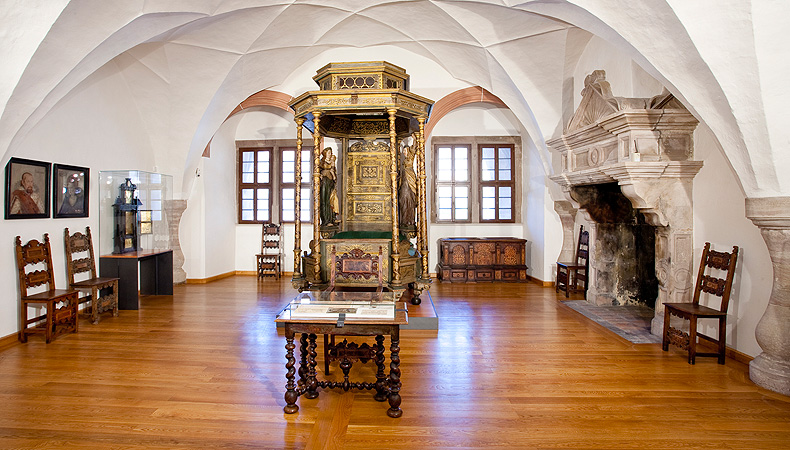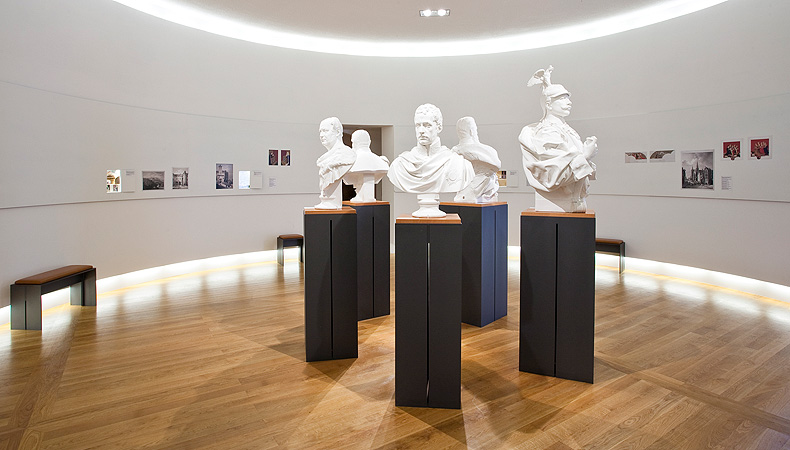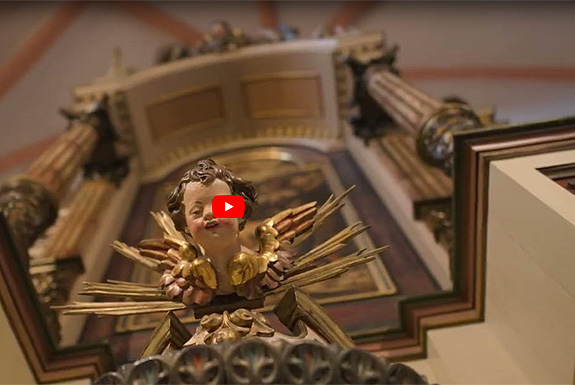Palaces > Plassenburg Castle at Kulmbach
Object description:
Plassenburg Castle – Kulmbach
Both princely residence and massive fortress, Plassenburg Castle is one of Bavaria’s most impressive historical buildings. The »Schöner Hof« (Beautiful Courtyard) with its richly decorated arcades has all the atmosphere of a German Renaissance court. The exterior fortifications testify to the effort required to remain politically independent in the Confessional Age. The power and pretensions of the burgraves of Nuremberg and the margraves of Brandenburg are nowhere as evident as in this castle. From 1338/40 to 1791, Plassenburg Castle was a ruling seat of the Franconian Hohenzollerns, and after this was a Prussian fortress until 1806.
The magnificent complex was built in its present form from 1557 for Margrave Georg Friedrich by the architect Caspar Vischer, after the original building on this site had been destroyed in the Second Margraves’ War. In place of the small castle which had been founded before 1135 by the Counts of Andechs, Vischer created a representative four-winged complex, fortified on the side facing the hill with massive bastions. Today Plassenburg Castle, situated high above Kulmbach, is a cultural centre of the Obermainland region. After destruction of the fortifications by order of Napoleon in 1806, the castle served until 1928 as a gaol and workhouse – it is now used for exhibitions, museums and special collections.
The Free State of Bavaria and the town of Kulmbach today maintain four museums under one roof:
-
The Hohenzollerns in Franconia museum is located in the historical rooms dating from the 16th century with their spectacular interiors and furnishings.
Princes and kings from the House of Hohenzollern significantly influenced the course of German history. The museum in Plassenburg Castle documents the history of this family – once burgraves of Nuremberg – who became powerful in Franconia and ruled here until 1806. Governing from the two centres of Ansbach and Kulmbach/Bayreuth, they shaped the development of Central and Upper Franconia by supporting the Reformation, encouraging the settlement of the Huguenots and introducing economic reforms. Franconia was the Hohenzollern’s power base for expanding into Brandenburg and Prussia. When the Franconian hereditary lines died out, the Prussian kings took over the Franconian homelands, which they ruled from 1792 to 1806. The new museum in the magnificent residential rooms of the 16th-century castle illustrates the life of princes in the Baroque age. It traces the progress of the Hohenzollerns from the Middle Ages, through the two margraviates of the 17th and 18th centuries to Prussian dominance and the endeavours of the Prussian kings to preserve the Franconian monuments of their family. The museum was established together with the »Haus der Bayerischen Geschichte« (House of Bavarian History) and the State Collections of Bavaria, in particular the Bavarian Army Museum. -
The Frederick the Great Army Museum has Prussian weapons and military items dating from 1700 to 1806.
The museum in the most important Hohenzollern fortress in Bavaria has the largest existing collection of old Prussian military items dating from 1700 to 1806, which are on display in 32 glass cases. It documents the outward appearance and inner structure of an army which altered the course of history on the battlefields of 18th-century Europe and focuses in particular on the time of Frederick the Great (1740-1786). The infantry and cavalry are described in detail, as well as the social structure of the troops. The main exhibits are firearms, swords, flags and paintings. The museum was established jointly with the collector and historian Bernd Windsheimer. -
The Deutsches Zinnfigurenmuseum (German Museum of Pewter Figures) has the largest collection of pewter figures in Germany, including the diorama with the most figures in the world: »The destruction of Kulmbach on St. Conrad’s Day 1553«.
-
In the Landschaftsmuseum Obermain (Museum of the Upper Main Region) the history and natural history of the town and the region are documented with a wide variety of exhibits and displays
Short film about Plassenburg Castle
Special exhibition
Glanzstücke aus 25 Jahren Armeemuseum Friedrich der Große
(Highlights from 25 years of the Frederick the Great Army Museum)
extended to 6 January 2026

The special exhibition features 60 special, often unique objects that have been acquired for the museum over the past 25 years.
The special exhibition is accessible during the opening hours of Plassenburg Castle and is included in the admission price.
Address
Festungsberg 27
95326 Kulmbach
09221 8220-0
Opening hours
April-September: 9 am-6 pm
open daily
October-March: 10 am-4 pm
closed Mondays
(except: 6 January, Easter Monday, 1 November)
Museum "The Hohenzollerns in Franconia": Guided tours only
Closed on: January 1, Shrove Tuesday, December 24/25/31
Guided tours
The Museum "The Hohenzollerns in Franconia" can be visited only with a guided tour (in German). The guided tours take place regularly.
The Army Museum, the Margravial Rooms and the castle church can be visited without a guided tour.
Guided tours on the castle (outside; in German)
1 May-30 September:
every Saturday at 2.15 pm
(approximately 90 minutes)
Admission fees 2025
5 euros regular
4 euros reduced
Castle ticket: 7 euros
(including the municipal museums at Plassenburg Castle)
Children under 18 are admitted free of charge.
Accessibility
Getting here / parking
Bayreuth or
Kulmbach
www.bahn.com
From Bayreuth: Bus to "Kulmbach/ Busbahnhof"
Bus services in Kulmbach:
www.stadtbus-kulmbach.de
No parking available at the castle
Further information
Free wi-fi available
Event rooms at Plassenburg Castle
Service (leaflets, photo/film, links…)
Deutsches Zinnfigurenmuseum
(German Tin Figure Museum, run by the town of Kulmbach)
Landschaftsmuseum Obermain
(Museum of the Upper Main Region, run by the town of Kulmbach)
Shop
09221 947-505
Drinks vending machine
(hot and cold drinks)
Burgschänke
09221 81313
al.castello.plassenburg @gmail.com
Café zur Weißen Frau
0175 1624729
info@partyservice-luthardt.de
Administrative office
Schloss- und Gartenverwaltung
Bayreuth-Eremitage
Ludwigstraße 21
95444 Bayreuth
0921 75969-0
Fax 0921 75969-15
sgvbayreuth@ bsv.bayern.de
www.bayreuth-wilhelmine.de





Facebook Instagram YouTube